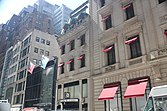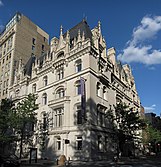C. P. H. Gilbert
C. P. H. Gilbert | |
|---|---|
Charles Pierrepont Henry Gilbert (August 29, 1861 – October 25, 1952[1]) was an American architect of the late-19th and early-20th centuries best known for designing townhouses and mansions.
Ancestry and early life
Born in New York City,
C. P. H. Gilbert's father was Loring Gilbert, a direct descendant of John Gilbert, the second son of Giles Gilbert of
C. P. H. Gilbert received a careful education, studying both in America and in Europe, including at the École des Beaux-Arts in Paris. After being prepared for college he took courses in civil engineering and architecture, and later studied painting, sculpture, and the fine arts in general. After college, he began practical work as an assistant in the office of a prominent firm of architects, where he received the training necessary to prepare him for engaging in his own business.[2] As a young man he designed buildings in the mining towns of Colorado and Arizona before returning to New York around 1885.
Career
In 1886, at the age of twenty-five, Gilbert began practicing as an architect in New York City, and received commission to design buildings of all kinds. One of his first projects was the design of fourteen brownstone rowhouses that now form a part of the Manhattan Avenue Historic District. Gilbert designed the block for Hoboken developer John Brown in 1886.[3]
Another noteworthy building was the 1888
He saw action during the Spanish–American War of 1898.[4] After the war he returned to New York.
By 1900 Gilbert had acquired a reputation as a specialist in designing opulent townhouses and mansions. Among his
Gilbert retreated from public life, and by the late 1920s stopped designing new houses. He retired to Pelham Manor, New York in Westchester County, where he died on October 25, 1952, at his home on 216 Townsend Avenue, at the age of 92.[1][4][7] He is interred at Woodlawn Cemetery in The Bronx, New York City.
Memberships
Gilbert was a member of numerous professional and social organizations, amongst them the
Family
Gilbert was married to Florence Cecil Moss, daughter of Theodore Moss of New York City, and had two children: Dudley Pierrepont Gilbert and Vera Pierrepont Gilbert.[2] He lived at 33 Riverside Drive and had a villa in Newport, Rhode Island at Ochre Point.[8]
Works
Gilbert's works include:
- 1881 –
- 1886 – Fourteen brownstowne rowhouses in the Manhattan Avenue Historic District: 120-40 Manhattan Avenue, 39–43 West 105th Street, 38–44 West 106th Street
- 1888–1904 – at least eight of the Montgomery Place mansions (#11, 14, 16–19, 21, 25, 36–50, 54–60), between 8th Avenue and Prospect Park, Brooklyn[6]
- c. 1889 – 313 and 315 Garfield Place, Brooklyn. Contrasting speculative houses.[6]
- c. 1890 – Joseph Hanan residence, Carroll Street and 8th Avenue, Park Slope, Brooklyn; demolished in the 1930s[6]
- c. 1895 – three adjoining mansions at the foot of Riverside Drive: 311 West 72nd Street, 1 Riverside Drive and 3 Riverside Drive for Philip Kleeberg[6]
- 1898 – Harry F. Sinclair House, 79th Street and Fifth Avenue, now housing the Ukrainian Institute
- 1898 – Cushman Building, Broadway and Maiden Lane, 1898 (previously the site of the Howard Hotel)
- 1900 – "Meudon", the massive 80-room Louis XVI-style revival Lattingtown
- c. 1900 – Franklin Winfield Woolworth mansion, 80th Street and Fifth Avenue; demolished[6]
- c. 1900 – Bankers Trust Company; his Greenwich, Connecticut estate is now known as Conyers Farm
- 1901 – Henry Seligman residence, 30 West 56th Street, now Aeffe USA[12]
- 1903 – 57 Dutch Colonial Revival style for Amos F. Eno, a son of Amos R. Eno
- 1904 – The Knabe Building, 437 Fifth Avenue
- 1905 – Polish Consulate General
- 1905 – Edward Holbrook House, 4 East 52nd Street, now the Cartier Building
- 1906–1908 – Jewish Museum
- 1913–1914 – Charlcôte House in Flat Rock Camp, constructed for Charlotte M. Bedell Paine; demolished 1980s
- 1914–1916 – Weckesser Hall, Wilkes University, Wilkes-Barre, Pennsylvania[13]
- 1915–1918 – Mrs. Seymour H. Knox House, 800 Delaware Avenue (formerly 806), Buffalo, New York, now the offices of Cellino Law[14]
- 1916–1918 – Convent of the Sacred Heart
- 1917 – Adolph Lewisohn residence, 9 West 57th Street, demolished[15]
- 1917 – 1067 Fifth Avenue, near 87th Street, apartment design in the French Gothic style[6]
- 1917–1918 – Augustus G. Paine Jr. residence, 31 East 69th Street, now Austrian Consulate General[16]
- 1919–1921 – Arthur and Alice Sachs residence, 42 East 69th Street, now Jewish National Fund[17]
- 1921 – Essex County National Bank, Willsboro (founded in 1923 by Augustus G. Paine Jr., today part of Champlain National Bank)[18]
- 1924–1925 – Seymour H. Knox II House, Buffalo, New York[19]
- 1929–1930 – Paine Memorial Library, Willsboro[20]
-
Harry F. Sinclair House on Fifth Avenue, as seen from 79th Street, now the Ukrainian Institute (1898)
-
57 Stone Street, constructed for Amos F. Eno (1903)
-
Cartier(1905)
-
Joseph Raphael De Lamar House, Madison Avenue and 37th Street, now the Polish Consulate General (1905)
-
Jewish Museum(1906–08)
-
Convent of the Sacred Heart(1916–1918)
-
Residence of Augustus G. Paine Jr., 31 East 69th Street, now the Austrian Consulate General (1917–18)
-
Residence of Arthur and Alice Sachs, 42 East 69th Street, now the Jewish National Fund (1919–21)
References
- ^ ISBN 0300055366., p.467
- ^ a b c d e f Harrison, Mitchell Charles, ed. (1902), "Charles Pierrepont Henry Gilbert", Prominent and Progressive Americans: An Encyclopædia of Contemporaneous Biography, vol. 1, New York: The Tribune Association, pp. 132–133
- ^ Postal, Matthew A.; Most, Jennifer L. et al. "Manhattan Avenue Historic District Designation Report" New York City Landmarks Preservation Commission (May 17, 2007)
- ^ a b "Obituary Charles Pierrepont H. Gilbert". The New York Times. October 27, 1952. Retrieved December 4, 2010.
- ^ Craven, Wayne. Gilded Mansions: Grand Architecture and High Society (2008) p. 310.
- ^ a b c d e f g h Gray, Christopher (February 9, 2003). "Streetscapes/Charles Pierrepont Henry Gilbert; A Designer of Lacy Mansions for the City's Eminent". The New York Times. Retrieved November 14, 2010.
- ^ Hasbrouk, Charles et al. "West End Collegiate Historical District Designation Report" Archived June 7, 2010, at the Wayback Machine New York City Landmarks Preservation Commission (January 3, 1984), pp.256-257
- ^ Staff (September 16, 1909). "Miss Vera Gilbert engaged" (PDF). The New York Times. Retrieved December 3, 2010.
- ^ Calderone, Michael (July 26, 2006). "A $32 Million Townhouse Sells on East 67th". The New York Observer. Archived from the original on October 21, 2012. Retrieved November 14, 2010.
- ^ Maher, James T. The Twilight of Splendor (1975) p. 336
- ^ Gray, Christopher (December 23, 2007). "Where Historic Town Houses Still Hold Court". The New York Times. Retrieved November 14, 2010.
- ^ Dunlap, David W. (July 24, 2007). "Two Midtown Town Houses Are Designated Landmarks". City Room. Retrieved May 29, 2021.
- ^ Manley, Bill (2011). "History". Archived from the original on November 30, 2010. Retrieved January 26, 2011.
- ^ LaChiusa, Chuck. "Knox House". buffaloah.com. Buffalo Architecture and History. Retrieved February 24, 2021.
- ^ Interiors were decorated by Hofstatter and Baumgarten and featured in House and Garden 1917 (John F. Pile, A History of Interior Design 2005:316).
- ^ Doane, Ralph Harrington (May 1919). "The Residence of Augustus G. Paine, Esq". The Architectural Review. VIII (5). New York: The Architectural Review, Inc.: 123–126.
- ^ Pearson, Marjorie et al. "Upper East Side Historic District Designation Report v.1" New York City Landmarks Preservation Commission (May 19, 1981) p.414
- ^ "Architecture of the Champlain Valley, Willsboro" (PDF). Adirondack Architectural Heritage. 2010. Archived from the original (PDF) on October 25, 2010. Retrieved November 1, 2010.
- ^ "History - Samuel H. Knox Jr. House"
- ^ "History". Paine Memorial Library. 2010. Retrieved November 14, 2010.[permanent dead link]
External links
- Pictures and Information on C.P.H. Gilbert's Historic Long Island Commissions
- Emporis page with list of commissions
- Gilbert, C. P. H. (1861-1952) // North Carolina Architects & Builders. A Biographical Dictionary (The NC State University Libraries).








